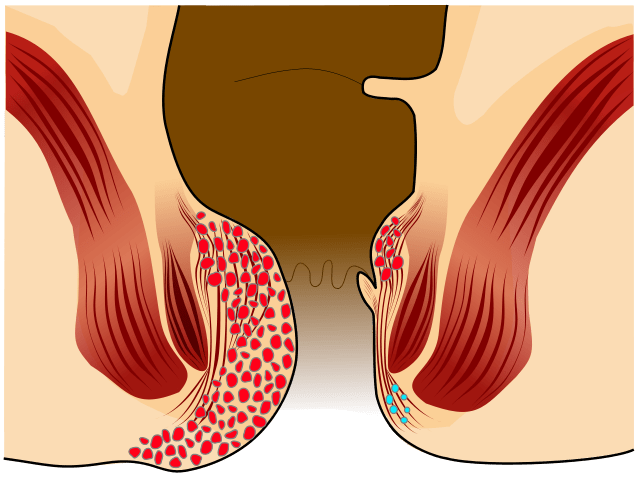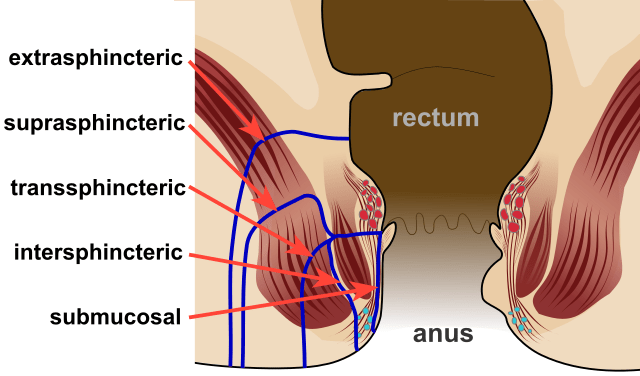Key Difference – Piles vs Fistula
Piles or internal hemorrhoids are a variety of hemorrhoids which can be defined as the varicosities of the tributaries of superior rectal vein covered by a mucous membrane. A fistula is a pathological track that is lined with granulation tissue or epithelium that connects two epithelial surfaces. In a morphological sense, piles can be considered as sacs having no opening to the outside. But fistulae have two openings at either end. This is the key difference between these two pathological lesions.
CONTENTS
1. Overview and Key Difference
2. What are Piles
3. What is Fistula
4. Side by Side Comparison – Piles vs Fistula in Tabular Form
5. Summary
What are Piles?
Piles are varicosities of the tributaries of superior rectal vein covered by a mucous membrane; these are also known as internal hemorrhoids. The tributaries that lie in 3’, 7’ and 11’ positions when viewed in the lithotomy position are particularly vulnerable to get hemorrhoids. The superior rectal vein is valveless and cannot control the flow of blood through it. In addition, it is located in the most dependable area of the capillary network of the anal canal. These contributory factors further increase the vulnerability of this region to get hemorrhoids.

Figure 02: Piles
There are three stages of internal hemorrhoids.
- First degree – piles remain inside the anal canal.
- Second degree – piles extrude from the anal canal during the defecation but later return to their normal position.
- Third degree – piles remain outside the anal canal.
Internal hemorrhoids do not cause any pain because they are innervated by autonomic afferent nerves.
Causes
- Family history of hemorrhoids
- Any disease that causes portal hypertension
- Chronic constipation
Symptoms
- Piles are usually painless
- Per rectal bleeding
- pruritus
What is Fistula?
A fistula is a pathological track that is lined with granulation tissue or epithelium that connects two epithelial surfaces. An anal fistula is a similar connection between the lumen of the anal canal or rectum and the perianal skin. An abscess that develops in the inter-sphincteric space can burst in two directions if kept untreated, creating the characteristic track with two openings. These lesions do not heal spontaneously because, mucus is forced out through the tract during defecation, inhibiting any damage repairing mechanisms.

Figure 02: Fistula
Associated Conditions
The occurrence of high-level fistulae is extremely rare. These advanced fistulae run from the rectum to the perianal skin and are located above the anorectal ring. Consequently, fecal matter consistently comes out through the opening on the skin surface soiling the clothes. But this does not happen in the low-level fistulae which are located below the anorectal ring.
Presentation
- Adults are more likely to get fistulae than children
- History of perianal abscesses
- Presence of a watery purulent discharge
- It is important to look for the symptoms of inflammatory bowel diseases
- Usually, the local lymph nodes are not enlarged
Sigmoidoscopy and proctoscopy can be used to exclude the possibility of Crohn’s disease or ulcerative colitis.
What is the Difference Between Piles and Fistula?
Piles vs Fistula | |
| The varicosities of the tributaries of superior rectal vein covered by a mucous membrane are known as internal hemorrhoids or piles. | A fistula is a pathological track that is lined with granulation tissue or epithelium that connects two epithelial surfaces. |
| Discharge | |
| There is no discharge. | There is a watery, purulent discharge. |
| Opening of the Sac | |
| This can be considered as a sac with no opening. | This has two openings at the either ends. |
Summary – Piles vs Fistula
A fistula is a pathological track that is lined with granulation tissue or epithelium that connects two epithelial surfaces. The varicosities of the tributaries of superior rectal vein covered by a mucous membrane are known as internal hemorrhoids or piles. The absence of any openings to outside in the piles is the key difference between piles and fistula, which helps us to identify the two conditions separately.
Download PDF Version of Piles vs Fistula
You can download PDF version of this article and use it for offline purposes as per citation note. Please download PDF version here Difference Between Piles and Fistula.
References:
1. Snell, Richard S. Clinical anatomy by regions. Baltimore, Md, Lippincott Williams & Wilkins, 2012.
2. Browse, Norman L. An Introduction to the symptoms and signs of surgical disease. London, Arnold, 1997.
Image Courtesy:
1. “Piles Grade 4” By Armin Kübelbeck (CC BY 3.0) via Commons Wikimedia
2. “Fistula diag 01” By McortNGHH – Own work (CC BY-SA 4.0) via Commons Wikimedia
ncG1vNJzZmivp6x7pbXFn5yrnZ6YsqOx07CcnqZemLyue8OinZ%2Bdopq7pLGMm5ytr5Wau268yKWcrGWRo7FuwtJmnaKrpKq5ons%3D